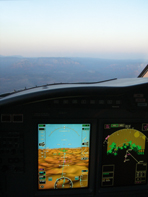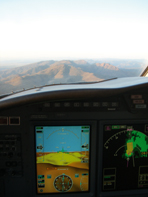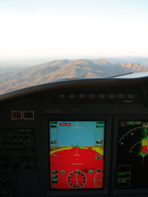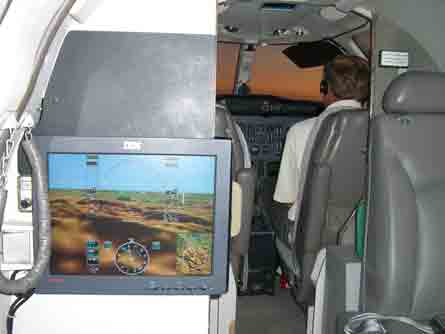Honeywell dared to meddle with the 'sacred' primary flight display by adding synthetic vision. We try it out and sample its tactical and strategic benefits
We are flying over the sprawling metropolis at night. Dotted amid the glittering expanses of city lights are black holes of impenetrable darkness which could be your landing area in the event of an emergency - or not.
|
|---|
A repeater display in the cabin shows ground detail hidden by dusk |
This night we are above Phoenix, Arizona in Honeywell's Cessna Citation V testbed, which is fitted with the company's new integrated primary flight display (IPFD). Looking through the cockpit windows to the ground 5,000ft (1,520m) below I see a dark space between widely spaced lights. Is it a flat field, undeveloped land or rough ground? Could I fly over that dark patch without concern for terrain? Looking down at the IPFD, I get an immediate answer. On a clear, three-dimensional image of the terrain below is a tall, unfriendly, rocky peak. No landing spot there.
This, in essence, is the advantage of the enhanced situational awareness provided by the synthetic vision technology at the heart of the IFPD. Adopted by Gulfstream as the synthetic vision - primary flight display (SVS-PD) for its G350, G450, G500 and G550 - all equipped with the PlaneView flightdeck based on Honeywell's Primus Epic integrated avionics - the system is set to be certificated by mid-2007 and promises to be a major aid to situational awareness.
The synthesised picture of the terrain ahead is derived from the digital database stored in Honeywell's enhanced ground proximity warning system (EGPWS), and does not use any images derived from infrared or other external enhanced-vision sensors. The synthetic image is produced by the IPFD processor, which renders the EGPWS data into a three-dimensional perspective view and combines it with aircraft navigation, altitude and air data.
Earlier that evening, before sunset, we made another flight to demonstrate how the same system aids the approach, provides depth cues and warns of encroaching terrain. With Honeywell flight operations chief pilot Jary Engels in the right seat, I was able to view the approach towards Turret Peak, one of the largest in the Tonto National Forest region north of Phoenix.
With the sinking sun to our left we approached the flattened 1,780m peak in a shallow descent that, without correction, would have taken us within 30m of the rocks. As we approached to 60s from potential impact, the EGPWS turned the terrain on the IPFD to yellow and triggered both visual and aural cautions. At 30s from impact, the mountain turned red on the IPFD, just as it would on a conventional EGPWS display. The words "pull up" flashed on the IPFD and the system triggered the same aural alert.
 |  |  |
|---|
As the mountain looms closer the IPFD colour changes to indicate 'terrain caution' (Yellow) and 'pull up' (red)
HUD symbology
Honeywell has added performance-based head-up display (HUD) symbology to the IPFD to aid the pilot, and resuming course for Sedona airport further north, Engels showed me how to use the flightpath marker and acceleration cue to fly the Citation. Using throttles and slight yoke adjustments to minimise the size of the acceleration cue on the left "wing" of the flightpath marker, I was quickly able to stabilise the aircraft. "Using the flightpath market has become natural to me," says Engels. "I can hold altitude and manage speed with it, and on final approach you can use it to make finer adjustments - though not too fine, otherwise you'd end up chasing it all over the place," he adds.
Although the IPFD cannot be used as a primary source of navigation, the general situational awareness provided by the display was well illustrated as we descended into the dusk and the 2,130m peaks surrounding Sedona. The airport, on a plateau in the valley, was virtually invisible in the twilight gloom, yet it was clearly indicated in light blue on the IPFD, having been earlier selected as the arrival airport in the flight management system (FMS).
Another useful aid was a series of range rings overlaid on the terrain, in this case at 9km (5nm) intervals. The extended centreline for the arrival runway also appeared as a distinct blue line on the display, and can be made to appear either automatically or manually when the radio navaids for the destination are selected. The Honeywell test aircraft did not have a full link established between the FMS and IPFD as the company is still developing the functionality, but this will standard on the production version, says electronic systems displays business and product manager Sergio Cecutta.
With the runway much easier to find thanks to the IPFD, we settled on a GPS-guided approach and used the flightpath marker as an aid to stabilising the Citation on the glideslope, despite a gusting 30kt (55km/h)-plus crosswind. Overshooting at 500ft, runway 03 was visibly detailed below the aircraft on the IPFD as we conducted a missed approach and turned tightly back towards the southwest. Given the proximity of the steep canyon walls and mountain slopes around Sedona, such a procedure would normally be highly unadvisable after dark, but was achieved with comfort thanks to the situational awareness provided by the IPFD.
"I didn't have to work at adjusting to the wind, as it is already done," says Engels. "Although it is a visual approach to the runway, you just put the flightpath symbol at the end of the runway and the wind correction is taken care of." But, he adds: "It is imperative for the pilot to still cross-check airspeed, altitude and deviation - all the usual things in the natural pilot's scan."
Returning to Honeywell's flight-test base at Deer Valley airport in north Phoenix, Engels first demonstrated how the IPFD could help the pilot's energy management with a simulated single engine failure. "In that situation it just becomes a much better PFD," he says. "We just put the flightpath on the acceleration cue and adjust."
Displaying the unusual-attitude recovery feature of the IPFD at 10,500ft, Engels raised the aircraft's nose and rolled sharply left. With increasing pitch angle, the solid line marking what had been the horizon became a dashed line as the flightpath became "non-conformal". The synthetic outside world picture faded away to be replaced by the solid brown earth and blue sky representation of a standard artificial horizon. Red chevron markers appeared, indicating the way back to straight and level flight.
Engels ignored this and, as the roll became more pronounced, three large directional chevrons and a super-sized aircraft symbol appeared on the display. Recovering the aircraft, the standard IPFD format returned. "This sort of inadvertent drift into an unusual attitude is more likely to happen in roll than in pitch, particularly in turbulence or while manoeuvering, or if the autopilot trips off," he says.
The IPFD is "really meant to be a complement to the INAV [integrated navigation] display of Epic, and this is taking that same level of integration and making it more tactical. The symbology allows you to move from aviate to navigate," says Honeywell human-centered systems research scientist Aaron Gannon. "We're simplifying the flight tasks by replicating the cues of visual flight. This gives you a system that is ambient, natural and continuous. Ambient, because the pilot makes no special effort to gather data - like sensing the temperature in a room without having to read a thermometer. It's natural because no special effort is made to interpret data - so you don't have to 'rotate' the image in your head when you look at it. And it's continuous because it doesn't require any effort to update the data."
Honeywell, however, was cautious in its approach from the start. "Rule number one was 'don't screw up the PFD'," says Gannon. Advanced vision systems programme manager Thea Feyereisen adds: "This was a real serious issue because we know this is the 'holy grail' of the cockpit instruments." To get it right from a human factors perspective, the development programme has included tests and reviews by hundreds of airline and corporate pilots, along with more than 750h of flight simulator tests and 200h of flight tests.
The system is a "strategic tool that helps you 'visual down' a chain of events and see in advance before it unfolds into a dangerous situation. It's also a tactical tool when it comes to ground proximity as it prevents decisions that sometimes lead towards controlled flight into terrain," Gannon says. Countering suggestions that pilots may become too transfixed "heads-down" in the cockpit with the IFPD, Feyereisen says research shows crews quickly become used to using the instrument as just another device. "It's only because this is the first time you have flown with it that you look at it this way," she adds.
Growth paths
With Gulfstream already on board, "many other OEMs are interested", says Cecutta, who adds the IFPD is intended to be the core of a family of Honeywell products. "Each of the [aircraft] manufacturers has their own version, so the basic functionality will be ported over to fit that." For the future, Honeywell is planning potential growth paths that include additional taxiway and airport surface feature maps. Further off is the prospect of synthetic- and enhanced-vision sensor fusion to address the "moose on the runway" issue of detecting transient obstructions. "We won't be tied to a specific sensor - it could be infrared, millimetre-wave or laser radar," he adds.
Source: Flight International
























